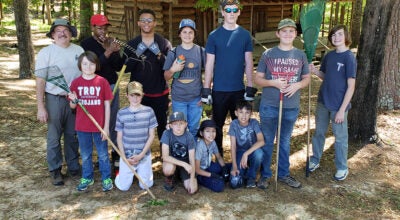AIM discusses program, funding hardships
Published 9:05 pm Thursday, June 24, 2010
‘im’ effective; ‘im’ taking a stand; ‘im’ proud; ‘im’ diligent; ‘im’ independent.
Those are some of the catch phrases that are used by the Abstinence in Motion (AIM) project that capture just how the organization wants local teens to feel as they battle with the temptations presented by modern culture.
The ‘im’ statements were illustrated cleverly on different visual aides at the Hampton Inn meeting room Thursday at an AIM project stakeholders meeting.
“The purpose of the meeting was to inform the community of what we’ve actually accomplished, our hopes for the future of the program and to see if we can continue our partnerships,” said Cora McMaster, AIM Project Director.
The AIM project seeks to reduce sexual activity among teens and pre-teens by providing education within schools, implementing peer support programs and developing community awareness.
The securing of partnerships is more important now than ever before, as the organization that helps adolescents face adversity, now has some hardships of its own to deal with.
“This is the first time we’ve been in this predicament,” McMaster said.
The problem is funding.
The AIM project, since its inception in 1997, has operated for the most part off of state and federal grants. Now there is much uncertainty as to whether that money will be available.
In 2006 AIM was awarded a Community Based Abstinence Education (CBAE) grant allotting $600,000 per year for five years.
“The government stopped all those funds as of September 29, 2010,” McMaster said.
After learning AIM would be forced to operate without the promised CBAE grant, another blow was dealt.
McMaster found out another primary source of support, Tile 5 funding, might have been lost, as well.
The Pike County-based organization has since been informed that the Title 5 funds will be released, but that comes with no guarantee and no specific date.
McMaster said the AIM project is in the unfortunate position of having to plan ahead without a definitive budget.
In response, AIM personnel have been scrambling to make ends meet and have recently applied to alternate funding sources.
“The strategy going forward is to research other grants and we are seeking foundation funding and other contributions,” McMaster said.
Many of those grants are very competitive so AIM can’t say with any certainty what the outcome will be.
So McMaster and her staff have set out to show just how important and effective the AIM project is at Thursday’s stakeholders meeting.
With the help of instructors such as Melodye Redding, Chelsey Hodge and Jeremiah Dalton, who shared their experiences in working with youth in the region, McMaster made a strong case for the impact of AIM.
Dalton took the floor after a vivacious presentation by Redding.
“Melodye is like that for six hours,” Dalton said of Redding’s work ethic and enthusiasm.
“The volume and the passion never drop.”
Dalton said the youthful and fervent approach taken by Redding and her fellow instructors in schools is crucial.
“There’s a culture out there that you’re up against,” he said.
Hodge agreed.
“Students are faced with so many negative pressures,” she said.
“It’s all over the media and they (students) think that it’s the truth.”
Sean Roehler, “Mentor Matters” Coordinator, described AIM’s peer mentoring efforts.
“There’s just something powerful about seeing your hero’s,” he said.
AIM trains upperclassmen, like recently graduated Charles Henderson High School class president Tara Youngblood, to counsel their peers.
Youngblood was at the meeting also and she talked about her time as a mentor, which started when she was in 10th grade.
“We have to train,” she said. “We have to learn things ourselves before we mentor the students.”
Youngblood said she really connected with students as a mentor in her senior year and she spoke to effectiveness of the AIM project in general.
“I’m thankful I had them to lead me down the right path,” she said. “I kind of wish we had a program in college.”
Youngblood is well aware that college will present its own pressures and challenges but she says she has a book provided by the AIM project that she can turn to for inspiration in rough times.
Mary Anne Mosack, an expert in the promotion of abstinence and a consultant in the field, gave her advice to the group and she was especially encouraged by Youngbloods’ resolve and use of the AIM book.
“That’s a lifeline to these kids that are inundated with MTV all day long.”
Mosack said focus was a key part of implementing plans and she stressed the importance of partnerships. She suggested medical providers, business entities, faith groups, civic organizations, safety directors, juvenile justice entities and County government agencies as potential allies for AIM.
Mosack said denying youth the proper information they need for success is “advantage discrimination.”
“We believe that youth deserve a message that gives them the best opportunity for health and life success,” she said.
“Teens are ten percent of the population but they are 100 percent of our future.”
The AIM Project has estimated serving over 100,000 youth and families in eight counties in south central Alabama. Students, school administrators, teachers and parents have all commended and requested their continued efforts.
Instructor Dalton said it would take partnerships in the community and stakeholders who want to make a difference to drive the program forward.
McMaster encouraged those who want to assist in that effort, or just learn more about AIM to log on to www.aimproject.com




